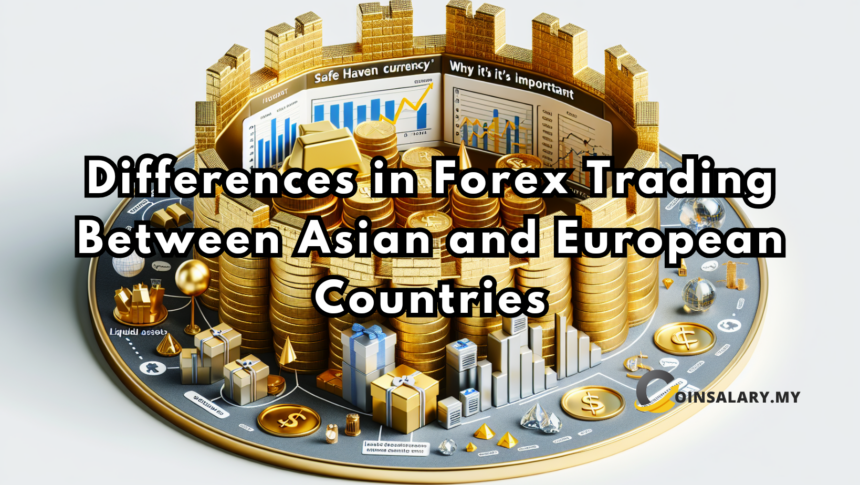The forex market is the largest and most liquid financial market globally, operating 24 hours a day across different time zones. However, the approach to forex trading varies significantly between regions, particularly in Asia and Europe. These differences are influenced by cultural, economic, regulatory, and market dynamics unique to each region.
This article explores the distinctions in forex trading between Asian and European countries, highlighting key factors that shape these markets.
1. Trading Hours and Market Sessions
The forex market operates through three major sessions: Asian, European, and American.
- Asian Trading Session
The Asian session, led by Tokyo, typically runs from 12:00 AM to 9:00 AM GMT. During this period, liquidity is moderate, and the market often experiences less volatility compared to other sessions. Currency pairs like USD/JPY and AUD/JPY are actively traded due to their relevance to regional economies. - European Trading Session
The European session, centered around London, is from 7:00 AM to 4:00 PM GMT. This is the most liquid session, with the highest trading volumes. Currency pairs like EUR/USD, GBP/USD, and EUR/GBP dominate trading activities, as Europe hosts major financial hubs.
Key Difference:
The European session is marked by higher volatility and liquidity compared to the Asian session, which is often more subdued and steady.
2. Market Volatility and Liquidity
- Asian Market Characteristics
Forex trading in Asia is often characterized by lower volatility. The market tends to follow trends set during the European and American sessions. Traders in Asia are also more conservative, focusing on technical analysis and range trading strategies. - European Market Characteristics
The European session experiences high volatility, driven by the overlap with the Asian and American sessions. The presence of major economic data releases, such as ECB policy decisions or UK economic reports, further intensifies market activity.
Key Difference:
The European market provides more opportunities for aggressive trading strategies, while the Asian market favors stability and cautious approaches.
3. Economic and Political Influences
- Asia
Forex trading in Asia is heavily influenced by regional economic powerhouses like China, Japan, and Australia. Events such as Bank of Japan (BOJ) policy changes, China’s GDP reports, or Australian employment data can significantly impact currency movements. Additionally, geopolitical factors, such as tensions in the South China Sea or trade relations with the US, play a critical role in shaping market sentiment. - Europe
Europe’s forex market is influenced by the European Central Bank (ECB), Brexit developments, and the performance of major economies like Germany and France. Political events, such as elections or EU policy changes, can cause significant volatility.
Key Difference:
Asian forex trading is more sensitive to regional economic data and geopolitics, while European trading is driven by broader macroeconomic trends and EU-wide developments.
4. Trading Culture and Strategies
- Asia
Traders in Asia are generally more conservative, emphasizing long-term investments and risk-averse strategies. Many retail traders prefer technical analysis and trade during specific hours when volatility is predictable. - Europe
European traders are more diverse in their approach, ranging from short-term scalpers to institutional investors executing complex strategies. The higher volatility in the European session attracts aggressive traders looking for quick profits.
Key Difference:
Asian traders lean towards stability and precision, while European traders embrace a mix of risk-taking and diverse strategies.
5. Regulation and Broker Presence
- Asian Regulation
Regulations in Asian countries vary widely. For example: - Japan enforces strict forex regulations, limiting leverage and ensuring robust investor protection.
- Other countries, such as Malaysia and Thailand, have more restrictive policies, often discouraging retail forex trading. Despite this, countries like Singapore and Hong Kong are recognized as forex hubs due to their open financial markets and transparent regulations.
- European Regulation
Europe is home to some of the world’s most reputable regulatory bodies, such as the Financial Conduct Authority (FCA) in the UK and the Cyprus Securities and Exchange Commission (CySEC). These regulators enforce strict guidelines, promoting transparency and safeguarding traders.
Key Difference:
Europe offers a more standardized and transparent regulatory environment compared to the fragmented and diverse regulatory landscape in Asia.
6. Preferred Currency Pairs
- Asia
Asian traders focus on currency pairs tied to regional economies, such as USD/JPY, AUD/USD, and NZD/JPY. The dominance of export-oriented economies in Asia makes these pairs highly relevant. - Europe
European traders primarily trade major pairs like EUR/USD, GBP/USD, and EUR/GBP, reflecting the importance of the Eurozone and the UK in global trade and finance.
Key Difference:
Asian traders prioritize regional currency pairs, while European traders favor globally dominant currencies.
7. Technology and Innovation
- Asia
The adoption of advanced trading platforms and AI-driven tools is growing in Asia, particularly in financial hubs like Singapore. However, retail traders in less developed markets may rely on simpler tools and strategies. - Europe
Europe leads in fintech innovation, with advanced trading platforms, algorithmic trading, and sophisticated analytics widely available. Institutional investors in Europe often leverage cutting-edge technologies.
Key Difference:
Europe has a technological edge in forex trading, while Asia is rapidly catching up, particularly in developed markets.
Conclusion
Forex trading in Asia and Europe reflects the unique economic, cultural, and regulatory landscapes of these regions.
- Asia caters to traders seeking stability, with a focus on regional currencies and risk-averse strategies.
- Europe offers high liquidity, volatility, and diverse trading opportunities, attracting both retail and institutional traders.
Ultimately, the choice of trading in either region depends on individual preferences, risk tolerance, and trading goals. Understanding these regional differences can help traders optimize their strategies and maximize potential returns.




